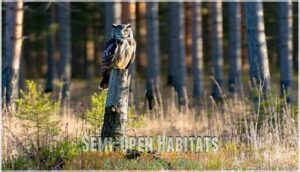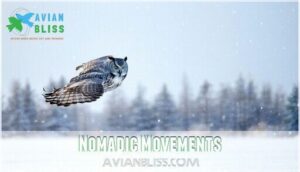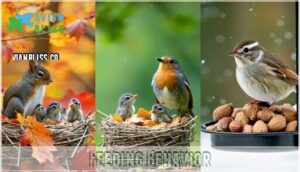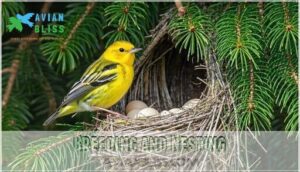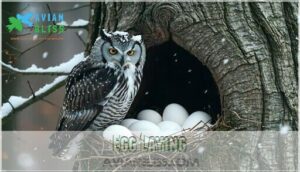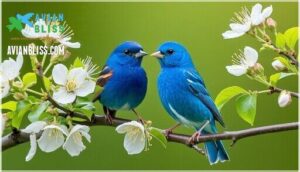This site is supported by our readers. We may earn a commission, at no cost to you, if you purchase through links.

This medium-sized bird sports a long tail, barred brown plumage, and fierce yellow eyes that scan boreal forests across Canada and Alaska.
Unlike its nocturnal cousins, you can spot this owl perched openly on treetops during daylight hours, hunting voles and small mammals with laser focus.
They’re nomadic wanderers who follow prey cycles, sometimes appearing far south when food runs scarce, and thrive in temperatures that’d freeze most creatures, calling pristine wilderness home where few dare venture.
Table Of Contents
- Key Takeaways
- Northern Hawk Owl Overview
- Habitat and Distribution
- Feeding Behavior
- Breeding and Nesting
- Conservation Status
- Frequently Asked Questions (FAQs)
- Is the Northern Hawk Owl endangered?
- What is the difference between a Northern Hawk Owl and a boreal owl?
- What are the predators of the hawk owl?
- What does it mean when you see an owl and a hawk?
- How do Northern Hawk Owls communicate with each other?
- What is the lifespan of a Northern Hawk Owl?
- Do Northern Hawk Owls migrate seasonally?
- How fast can a Northern Hawk Owl fly?
- Are there any cultural or mythological associations with Northern Hawk Owls?
- How long do northern hawk owls live?
- Conclusion
Key Takeaways
- You’ll spot northern hawk owls hunting during the day, unlike most owls, perching openly on treetops with their distinctive hawk-like silhouette and long tail as they scan for voles and small mammals.
- You can find these medium-sized owls in boreal forests across Canada, Alaska, Scandinavia, and northern Russia, where they’re nomadic wanderers that follow prey cycles and sometimes appear far south when food runs scarce.
- You’ll recognize them by their fierce yellow-orange eyes, mottled dark brown and white barred plumage, and compact crow-sized build that’s perfectly adapted for surviving in freezing wilderness temperatures.
- You should know they’re not endangered but face conservation challenges from habitat loss due to logging and climate change, with an estimated global population of 200,000 individuals that depends heavily on rodent availability for breeding success.
Northern Hawk Owl Overview
You’ll find the northern hawk owl in the boreal forests of the Northern Hemisphere, where its hawk-like flight and sharp hunting skills set it apart.
This medium-sized owl combines striking features like a long tail and yellow-orange eyes with behavior that’s both fascinating and efficient.
Physical Description
The northern hawk owl (Surnia ulula) stands out with its medium size and slender build, resembling a hawk in flight.
Its plumage details include mottled dark brown above and white with dark barring below.
The owl’s facial disk, yellow-orange eyes, and feathered legs highlight its cold-weather adaptations.
With pointed wings and a long tail, its flight adaptations are unique.
Identification Features
Spotting a northern hawk owl is easier when you know what to look for.
Its long tail, compact size, and hawk-like flight style stand out.
The facial disk, framed by a black border, and yellow-orange eyes give it a distinct look.
Its plumage details—mottled dark brown above, white with dark barring below—make owl identification straightforward.
Listen for its non-silent flight, which is a key characteristic, along with its compact size.
Size Comparison
In terms of owl size, the Northern Hawk Owl sits between a Boreal Owl and a Great Horned Owl.
Think of it as a crow-sized bird with a length of 14.2-17.7 inches and a wingspan of about 28 inches.
Its weight variation, from 8.5-16 ounces, highlights its slender shape, perfect for boreal forests.
Habitat and Distribution
You’ll find northern hawk owls across the boreal forests of Alaska, northern Canada, Scandinavia, and northern Russia where they prefer semi-open areas with tall trees for perching.
These nomadic birds don’t follow regular migration patterns but instead move across their range based on prey availability and weather conditions.
Boreal Forests
You’ll find northern hawk owls thriving throughout the boreal forest belt that circles the northern hemisphere.
These vast coniferous forests, also called taiga, provide the perfect backdrop for their hunting lifestyle. Unlike the nocturnal boreal owl, northern hawk owls adapt brilliantly to these ecosystems where spruce and fir trees dominate the landscape.
Many resources are available for those interested in boreal forest products.
Here’s what makes boreal forests ideal for northern hawk owls:
- Forest Biodiversity supports abundant small mammal populations that form the owl’s primary food source
- Climate Regulation maintains the cold temperatures these Arctic-adapted birds need to survive year-round
- Resource Extraction activities create the semi-open clearings where these owls prefer to hunt from exposed perches
Semi-Open Habitats
You’ll find northern hawk owls thriving in semi-open habitats where forest edges meet clearings.
These open boreal forests provide ideal perch availability on tall snags and trees.
The birds need nesting proximity to dense cover while maintaining access to hunting grounds.
Forest edges create perfect conditions where prey abundance peaks.
Habitat fragmentation actually benefits these adaptable hunters in their owl habitat preferences, providing them with an environment where they can thrive due to the presence of dense cover.
Nomadic Movements
You’ll find northern hawk owls are truly nomadic wanderers, constantly shifting across their range based on prey availability and climatic conditions.
When food scarcity strikes, these adaptable birds undertake remarkable irruptions:
- Range shifts can span thousands of miles during harsh winters
- Migration patterns follow prey abundance rather than seasonal timing
- Irruption causes include severe weather and declining rodent populations
- Prey scarcity triggers unexpected southern movements for survival
Feeding Behavior
When you observe a Northern Hawk Owl hunting, you’ll notice it acts more like a hawk than a traditional owl by actively searching for prey during daylight hours.
You can watch these skilled hunters perch on tall trees and poles as they scan open areas for small mammals moving beneath the snow, exhibiting traditional hunting behavior.
Diurnal Hunting
Unlike most nocturnal cousins, you’ll find the northern hawk owl actively hunting during daylight hours.
This diurnal owl employs distinctive hunting techniques that mirror hawks more than traditional owls.
You’ll observe them perching on tall snags, scanning open areas before swooping down with direct flight patterns.
Consider using a hawk owl camera to observe these behaviors more closely.
Their hunting strategies adapt seasonally, maximizing energy expenditure efficiency throughout changing prey cycles.
Prey Detection
You’ll discover northern hawk owl prey detection relies on extraordinary sensory abilities that make these birds exceptional hunters.
Their auditory acuity allows them to hear rodents moving beneath a foot of snow, while their visual range spans vast territories from carefully chosen perch selection points.
- Snow penetration hearing – Can detect voles and lemmings moving up to 12 inches below snow surface
- Hovering technique – Uses brief aerial suspension to pinpoint exact prey location before striking
- Strategic perch selection – Chooses elevated positions along forest edges for ideal hunting coverage
- Enhanced visual range – Spots movement across open areas from distances exceeding 100 yards
Diet Composition
Small mammals dominate the Northern Hawk Owl’s diet, with voles and mice comprising the majority of meals.
These skilled hunters feast almost exclusively on small mammals, making voles and mice their daily bread.
You’ll notice seasonal variation as these owls shift from summer’s rodent focus to winter’s increased bird consumption.
Bank voles remain essential during breeding season, while Microtus voles become available as snow melts.
Dietary adaptations allow them to handle various prey sizes effectively.
Breeding and Nesting
When you observe northern hawk owls during breeding season from April to May, you’ll notice they choose tree cavities or broken snags 10-40 feet above ground for their nests.
You can expect females to lay 3-7 white eggs and incubate them alone for 25-30 days while males provide all the food during this critical period.
Nesting Sites
You’ll find Northern Hawk Owls nesting in tree cavities, broken snags, or abandoned nests from other birds.
Their fierce nest defense makes them fearless protectors of their chosen nesting spots, which are typically cavities 10-40 feet above ground, though nest reuse rarely occurs at the same site.
In northern Europe, they’ll readily accept artificial nest boxes, and some enthusiasts even purchase hawk owl nests to support local populations.
Egg Laying
Once you’ve chosen a nesting site, the female begins egg laying in April and early May.
She typically lays 3-7 white eggs, though clutch size can reach up to 13 during years when prey is abundant.
The laying frequency depends on rodent availability in her territory, which represents a careful investment in the next generation’s survival and development, as each egg is laid with the intention of ensuring the species’ continuation and survival.
Incubation Period
Once eggs are laid, the northern hawk owl’s incubation period begins.
Female owls take sole responsibility for warming the eggs during this 25-30 day process.
Temperature effects play a pivotal role in egg development and hatching success.
The incubation length varies slightly based on environmental conditions.
During nesting, males don’t participate in incubation but focus on hunting and territory defense instead.
Parental Care
After eggs hatch, you’ll witness remarkable parental care from these monogamous pairs.
Both parents share feeding duties, with males initially handling food storage near the nest.
They’ll fiercely defend their territory through aggressive nest defense behaviors.
During courtship, you might hear their distinctive duet calls echoing through the forest.
Fledgling dependence extends several months, with parents continuously supporting their young until independence.
Conservation Status
You’ll find that northern hawk owls face several conservation challenges that threaten their populations across their range.
These birds are vulnerable to habitat loss from logging and climate change while maintaining low population densities throughout their boreal forest homes.
Vulnerability Factors
Although northern hawk owls face multiple threats across their range, you’ll find that human activities pose the greatest risks to their survival.
Climate change disrupts their delicate ecosystem balance while habitat degradation reduces suitable nesting sites.
Key vulnerability factors include:
- Human disturbance through shooting and vehicle collisions
- Food scarcity during harsh winters
- Fire suppression altering natural forest cycles, which can be considered a result of climate change and leads to habitat degradation.
Habitat Loss
Looking beyond immediate threats, habitat loss poses the greatest long-term challenge for northern hawk owls.
Logging operations fragment their boreal forest homes, reducing available nesting sites and disrupting prey populations.
You’ll find these owls struggling as their habitat requirements become harder to meet.
| Threat Type | Impact on Owls | Geographic Scale |
|---|---|---|
| Forest Fragmentation | Reduced nesting sites | Regional |
| Prey Scarcity | Decreased breeding success | Local to regional |
| Range Reduction | Population isolation | Continental |
Climate Change Impact
Climate change reshapes Northern Hawk Owl survival patterns through dramatic range changes and increased irruption frequency.
Climate shifts force these Arctic hunters into unpredictable journeys, rewriting ancient migration maps with each warming season.
You’ll notice these birds face prey scarcity as warming temperatures alter small mammal populations.
Habitat shift from traditional boreal forests reduces nesting success rates.
Bird conservation efforts now focus on wildlife conservation strategies that address habitat loss and unpredictable bird migration patterns affecting their circumpolar distribution.
Population Density
Population tracking for Northern Hawk Owls proves challenging due to their nomadic nature and remote breeding locations.
Scientists estimate global population between 200,000 individuals worldwide, with North America hosting 20,000-100,000 breeding pairs.
Key factors affecting bird population density include:
- Prey availability fluctuations
- Habitat quality variations
- Irruption events during food shortages
- Climate effects on range size.
Rodent populations directly influence conservation status, and are a crucial aspect of understanding the population dynamics of the Northern Hawk Owls.
Frequently Asked Questions (FAQs)
Is the Northern Hawk Owl endangered?
Northern Hawk Owls aren’t endangered despite covering thousands of miles during population irruptions.
You’ll find their conservation status remains stable across boreal forests, though they’re vulnerable to habitat loss from climate change and logging, which affects their population due to habitat loss.
What is the difference between a Northern Hawk Owl and a boreal owl?
You’ll notice the hawk owl is larger with a longer tail and yellow eyes.
While boreal owls are smaller, more compact, with darker facial disks and different hunting patterns during daylight hours, which can be a key distinction.
What are the predators of the hawk owl?
Like a fortress under siege, you’ll find hawk owls face threats from larger raptors including great horned owls, goshawks, and peregrine falcons.
Ground predators like martens, lynx, and bears also target their nests and young.
What does it mean when you see an owl and a hawk?
Seeing an owl and hawk together isn’t common since they hunt different times.
You’re witnessing rare behavior – perhaps territorial disputes, prey competition, or seasonal overlap.
Both are skilled predators adapting to circumstances.
How do Northern Hawk Owls communicate with each other?
Picture two owls perched on opposite spruces, calling back and forth at dawn.
You’ll hear Northern Hawk Owls communicate through varied calls, duet songs during courtship, and visual displays like stiff bowing to establish territories and attract mates, which includes visual displays.
What is the lifespan of a Northern Hawk Owl?
You’ll find these remarkable owls typically live around 10 years in the wild.
Their lifespan depends on food availability, harsh northern weather conditions, and predation risks they face throughout their circumpolar range.
Do Northern Hawk Owls migrate seasonally?
Birds of a feather don’t always flock together in the case of Northern Hawk Owls.
You’ll find they’re largely non-migratory residents, but they’ll irrupt southward during harsh winters when prey becomes scarce in their boreal territories.
How fast can a Northern Hawk Owl fly?
Flight speeds aren’t precisely documented for Northern Hawk Owls, but you’ll observe their swift, direct flight resembles hawks more than typical owls.
They’re fast enough to catch birds mid-air and hover briefly while hunting.
Are there any cultural or mythological associations with Northern Hawk Owls?
You won’t find many cultural legends about these birds.
Unlike Great Horned Owls, they lack strong mythological ties.
Some Inuit traditions view them as weather predictors, but cultural associations remain limited across most cultures.
How long do northern hawk owls live?
You’ll find these remarkable owls typically live around 10 years in the wild.
Their lifespan can vary based on food availability, predation, and harsh northern climates they call home throughout the boreal forests.
Conclusion
Like Athena’s owl symbolizing wisdom through keen observation, the northern hawk owl teaches us about adaptation and survival in Earth’s harshest environments.
You’ve discovered how this remarkable raptor defies typical owl behavior through diurnal hunting and nomadic lifestyle.
Understanding the northern hawk owl’s unique ecology helps scientists monitor boreal forest health and climate impacts.
As habitat pressures increase, protecting these wilderness areas becomes essential for maintaining stable populations of this extraordinary Arctic predator.



